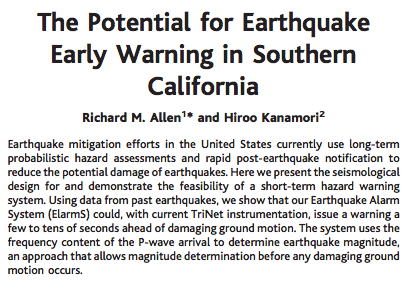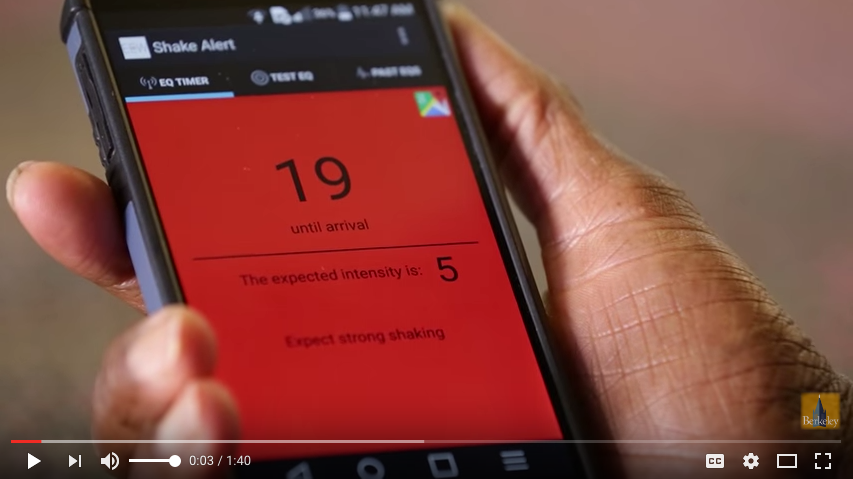
ShakeAlert is the prototype earthquake early warning system now under development in the United States. The system uses traditional seismic and geodetic sensors across the US west coast to detect earthquakes, determine their size and location, then transmit a warning to users seconds to minutes before damaging ground shaking arrives. The implementation is a collaboration between the US Geological Survey, UC Berkeley, Caltech, and the Universities of Washington and Oregon.
For more on how ShakeAlert and earthquake early warning works, visit our Berkeley Seismo Lab Earthquake Early Warning pages.
Highlights of the Berkeley contributions to ShakeAlert
The path to public alerts in the US begins with science and expands to include public policy, broad stakeholder engagement, and advocacy. Below are some of the highlights of the path so far.
May 2017: US Congress provides $10.2 million for ShakeAlert
The FY17 omnibus spending bill signed into law May 5, 2017 provides $10.2 million in funding to continue the build-out of ShakeAlert. Three dozen members of Congress urged their fellow lawmakers to increase the federal funding level for the warning system to the $16.1 million per year needed to operate the completed system. This represents a $2 million increase over the funding provided by Congress last year.
April 2017: The ShakeAlert prototype becomes west-coast wide
The prototype ShakeAlert system was extended to include the Pacific Northwest meaning that test users in California, Oregon and Washington can now receive alerts.
June 2016: California provides $10 million for ShakeAlert
Gov. Jerry Brown signed the state budget that included $10 million to further the development of ShakeAlert in California. Although California passed a mandate in 2013 to create a statewide earthquake warning system, this is the first money appropriated by the state to make it a reality.
February 2016: White House summit highlights the potential of ShakeAlert
On February 2nd, 2016 the White House hosted a one-day summit on earthquake resilience to promote the concept of earthquake early warning and the development of ShakeAlert. John Holden, the President’s Science advisor opened the summit followed by Sally Jewell, the Secretary for the Interior; both explained the value of earthquake early warning to the United States. In the first panel titled “The Promise of Earthquake Early Warning” (video above) Richard Allen outlined the status of early warning and John McPartland from BART discussed the value of early warning to train systems. The panel was then interrupted as Congressional representatives needed to leave early for a vote on the Hill. Senator Merkley, and Representatives DeFazio, Shiff and Kilmer from the states of California, Oregon and Washington all spoke of their desire to see warnings funded and implemented. The panel resumed with John Vidale (U. Washington) laying out the implementation plan, and finally Robert Kirshner from the Moore Foundation announced new commitments to the project from various federal, state and private entities, including an additional $3.6M from the Moore Foundation. The summit was highly effective, stimulating discussions in California about what more the state could do to bring public warnings sooner.
December 2015: US Congress provides $8.2 million for ShakeAlert
Lawmakers included $8.2 million in funding for ShakeAlert in their FY15 budget, a more than $3 million increase over last year. Rep. Adam Schiff (D-Burbank) called the spending a “very substantial sum in these budget-constrained times.” Schiff pointed out that it would take another $30 million or so to finish building the system, and an additional $16 million a year to run it. “We’ve gone a long way with this warning system, and I’m hopeful over the next few years we’ll have it fully installed,” said Rep. Ken Calvert (R-Corona), who is chairman of the appropriations subcommittee that oversees funding for earthquake programs.
December 2014: US Congress provides $5 million for ShakeAlert
Congress approved $5 million for the development of the West Coast’s earthquake early-warning system. This is the first funding provided by Congress to begin the transition towards a public warning system. The total cost of the system is estimated to require a $30 million one-time build-out cost, and then $16 million per year to operate. This is in addition to funding already provided to run the seismic networks in the US.
August 2015: International meeting: “Implementing Earthquake Alerts” at UC Berkeley

The Third International Conference on Earthquake Early Warning: Implementing Earthquake Alerts, to be hosted by UC Berkeley had been planned for months. The occurrence of the Napa earthquake shaking the entire San Francisco Bay Area just two weeks before the event created a buzz around the meeting that we had not anticipated. The opening session (pictured above) included (from left to right) Prof. Richard Allen, state Sen. Jerry Hill, Lt. Gov. Gavin Newsom, state Sen. Alex Padilla, Office of Emergency Services director Mark Ghilarducci, San Francisco Mayor Ed Lee and USGS acting director Suzette Kimball.
August 2014: ShakeAlert provides warning in Napa quake
The M6 Napa earthquake at 3:20am on August 24, 2014 rattled the entire San Francisco Bay Area. Damage was mostly confined to the Napa area, but the entire region was reminded of the earthquake threat. ShakeAlert issues a warning to the test users in the Bay Area including BART, San Francisco Emergency Management, UC Police, and Google. The alert came from Berkeley’s ElarmS algorithm.
September 2013: California’s Earthquake Early Warning Legislation
Governor Jerry Brown signed Senate Bill 135 by Senator Alex Padilla (D-Pacoima), which requires that the Office of Emergency Services develop a comprehensive statewide earthquake early warning system to alert Californians in advance of dangerous shaking. "I applaud Governor Brown for his vision and leadership. We live in earthquake country. He understands that when it comes to earthquakes in California, it is not a matter of if, but when,” said Senator Alex Padilla. “With Governor Brown’s signature, the process of developing a statewide earthquake early warning system has begun,” said Senator Alex Padilla. While the legislation initiated the development of a warning system, no funding was provided.


September 2012: San Francisco’s BART system first to use ShakeAlert

From the San Francisco Examiner: "Operating a transit system in one of the most earthquake-prone areas in the country can be a perilous task. Knowing this, BART is taking no risks. Working with UC Berkeley, the transit agency is the first in the nation to install an automated early warning earthquake system, which will provide BART with precious extra seconds to slow down or stop trains before a temblor hits the tracks."
November 2011: Moore Foundation awards $6.5 million for development of ShakeAlert

The Moore Foundation support was ShakeAlert’s springboard from an academic research project, to a public safety system. Following the Tohoku-Oki earthquake and earthquake early warning summit at Berkeley, the Gordon and Betty Moore Foundation partnered with the ShakeAlert team to propel the project forward. They invested $6.5 million in research support at Berkeley, Caltech and U. Washington, as well as providing support to the USGS. The goal was to complete the demonstration system to the point that federal and state funding could be justified to deliver on a fully operational public early warning system. Not only did the Moore Foundation provide research support, they also assisted with stakeholder building, communications and outreach.
April 2011: Earthquake Early Warning Summit - UC Berkeley
Shortly after the M9 Tohoku-Oki earthquake in Japan, Berkeley organized an early warning summit bringing together scientists, business leaders and legislators to review the performance of the warning system in Japan, and assess the status of the testing of ShakeAlert in the US. The summit produced a resolution on the technical capabilities of early warning and lead to a plan of how to more early warning forward in the US through partnerships between the universities, federal agencies, private industry and foundations. In the same month, Scientific American published an article about the capabilities of early warning and the development in the US.
February 2011: ShakeAlert starts providing warnings to test users
While ShakeAlert had been providing alerts to project scientists for over a year, the project started to provide alerts to test users outside of the project. This started with other seismologists, but quickly grew to other groups interested in receiving the alerts, event from a research system. The “UserDisplay” software was provided to these users. This desktop app pops up on your computer with an audible alert when an earthquake is detected. Knowing the location of the user, the app estimates the expected shaking intensity at the user’s location, and counts down until the shaking arrives. The video shows the UserDisplay alert for the 2014 M6 Napa earthquake as received at UC Berkeley.
October 2007: ElarmS realtime testing begins in California: Alum Rock earthquake

After offline testing of the ElarmS algorithm using earthquake data from around the world, online realtime testing begins in northern California at Berkeley. Two weeks after the online testing began, the October 31, 2007, M5.4 Alum Rock earthquake struck the south San Francisco Bay Area, the largest earthquake since the 1989 Loma Prieta earthquake. ElarmS successfully detected the the event and issues an (internal) alert. This performance was reported in the 2009 GRL article.
August 2006: The ShakeAlert project is born

The US Geological Survey funded UC Berkeley and Caltech to begin collaborative development of ShakeAlert for California. The ShakeAlert earthquake early warning project started to test three earthquake early warning algorithms including UC Berkeley’s ElarmS. The initial goal was to take algorithms developed offline, and start testing in real-time. Also, the test system should span all of California bringing together the data feeds from both Berkeley and Caltech.
May 2006: Probabilistic warning times for San Francisco Bay Area
Having developed the ElarmS methodology to rapidly detect earthquakes and issue an alert, the question remained: how much warning will there be? The amount of warning is primarily dependent on the location of the earthquake epicenter with respect to the users. Using the probabilities of future earthquakes in northern California, we can estimate the warning times for each earthquake scenario and therefor determine probabilistic warning times. Read full paper

May 2003: “The potential for earthquake early warning in southern California” published in Science

Richard Allen and Hiroo Kanamori outline a methodology for earthquake early warning developed using data from the seismic network in southern California. This work was included in Discovery magazine’s top science discoveries for 2003. The approach is at the heart of the ElarmS.
January 2003: US Geological Survey provides first research funding for early warning
Following the initial development of the early warning concept in southern California, the USGS NEHRP program provided one year of research funding to continue the development. This was the first funding provided by the USGS for early warning development in the United States.
January 2001: Earthquake early warning postdoc
Development of the ElarmS earthquake early warning algorithm started at Caltech funded by the Texaco Prize Postdoctoral Fellowship. This work was a collaboration between Richard Allen and his postdoctoral advisor Hiroo Kanamori.





